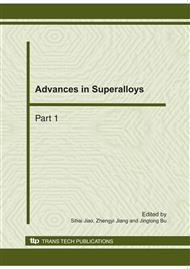p.1243
p.1247
p.1252
p.1256
p.1260
p.1265
p.1270
p.1278
p.1285
Research on Surface Corrosion of the Adaptive Expandable Inner Bracing Screen
Abstract:
The surface corrosion mechanism of the adaptable and expandable inner bracing screen is introduced, experiment and analysis was made for the surface corrosion with the effect of temperature, chloride ion, calcium ion, pH value, this offer help to the application of adaptable and expandable sand control screen. The results show that surface corrosion rate is expedited with the temperature increase during 30 °C~80 °C, it reach the highest spot at 80 °C and then declined. The screen surface occur dot-corrosion easily in solution which contain chlorine ion, corrosion rate decline with the concentration increase of chlorine ion. Calcium ion can restrain the screen surface corrosion rate. Corrosion rate is decline with the pH value increase during the pH value of 3~6.
Info:
Periodical:
Pages:
1260-1264
Citation:
Online since:
October 2010
Authors:
Price:
Сopyright:
© 2011 Trans Tech Publications Ltd. All Rights Reserved
Share:
Citation:


